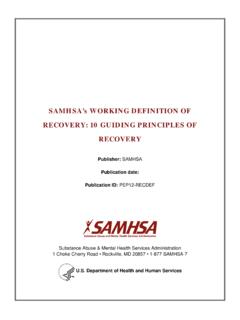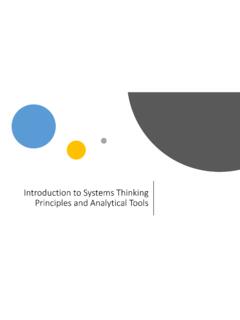Transcription of Coproduction putting principles into practice
1 Co- productionPutting principles into practice in mental health contextsCath Roper / Flick Grey / Emma Cadogan Co- production - putting principles into practice in mental health contexts2018 Cath Roper, Flick Grey & Emma CadoganThis work is licensed under a Creative Commons Attribution licence. It is a condition of this license that the authors are credited if content is adapted or replicated. Queries in relation to this resource can be directed to by Mahlie Jewell Introduction .. What is co- production ?.
2 Why should we co-produce? ..What can be co-produced? .. Types of consumer participation .. Consumer perspective .. How does co- production differ from other participation? ..Co- production : core principles ..Power .. Experiences of power in different contexts .. Old power and new power .. Bringing power to awareness .. Addressing power imbalances ..The challenges of co- production ..Critical elements for co- production .. Preparing for co- production .. Setting the agenda .. Who should be involved? .. What else needs to be considered?
3 Bringing co- production partners Lessons from a co- production project ..Co- production in practice case studies .. The Understanding & Involvement (U&I) Project .. Electro Convulsive Therapy (ECT) dialogue tool project .. Psych Action & Training Group (PAT) - Growing service user perspective in academia .. mental Health Experience Co-design (MH ECO) .. Mind Recovery College ..Useful resources .. References ..Acknowledgments .. Appendix A. Questions for consideration prior to co- production Appendix B. Questions for discussion when bringing co- production partners together Appendix C.
4 Sample agenda for first-time meetings with co- production partners Appendix D: Ideas for icebreakers Appendix E. Mapping power Contents12334456779101011111212121213151 71719202122242526Co- production - putting principles into practice in mental health contextsThis resource seeks to explain what co- production is, how it is important, how it is different to other participatory approaches, and specific considerations for mental health and similar contexts in which extreme power differentials are likely to have been experienced by co- production partners.
5 It offers advice on establishing the culture and mindsets from which co- production can take place. It is a resource that we hope will influence approaches to mental health work, policy development, and consumer participation. Co- production is a way for participants with different expertise to collaboratively work together. The term co- production is frequently used in public service discourse, but has become something of a buzzword lacking robust conceptual or practical foundations; in this resource we explore how co- production goes beyond traditional consumer participation models.
6 In fact, co- production is not a model, rather it is a theory with a set of values and principles . Moving beyond traditional participation models is a challenge to the status quo for many government departments and service-delivery organisations, and even for consumers unaccustomed to having real power. This resource has been developed to inform and support understanding, planning, and implementing co- production initiatives specifically within the context of Victorian mental health services. There are some unique considerations to be addressed when mental health consumers, clinicians, health service and other agency staff co-produce together to ensure that throughout the process, consumers are positioned as knowledge holders, leaders and people from whom there is much to learn.
7 We know that a diagnosis of mental illness can position people as being sick, suffering, irrational or even scary and, even though we try not to be negatively influenced, such fears and thoughts can impact on how we all work together. Very few people are immune to cultural stereotypes and most mental health workers are more familiar with being in an influential clinical relationship with consumers, rather than a co-producing one. Although there are a number of excellent co- production resources (some of which are presented in this document), there are few that take into account the specific challenges of working co-productively in the mental health context.
8 IntroductionBY CO- production PART NERS Page 2 There has been growing interest in co- production in the past decade, particularly in the UK, in the context of promoting partnerships between governments, services, service users and communities in the commissioning and development of health and community services (Boyle & Thomas, 2009). In service contexts co- production is seen as enabling people s democratic rights to shape the services they use as well as being underpinned by the principle that service users have unique knowledge and skills that are essential to providing a quality relationships between individual consumers and professionals (such as health professionals) in a service-delivery context should not be described as co- production .
9 In this context the collaborative process should be referred to as shared or supported decision-making (depending on whether decisions are shared or led by the consumer).Co- production has diverse roots, therefore when people speak of co- production , they may have different understandings of what it is. The term was originally coined by the political economist Eleanor Ostrom in the 1970s (Ostrom & Ostrom, 1978). Later, Edgar Cahn s work on the core economy and Timebanking laid strong social justice and community-development foundations of co- production (Cahn, 2000) and many of the principles Cahn advocated, such as reciprocity and recognising people as assets, have become core principles in the contemporary co- production literature.
10 The field of co-design has been an important influence for co- production . Co-design engages end-users in the design of products or services so they will better serve their intended purpose. It is not possible to engage in robust co- production without also engaging in co-design. Planning, designing and producing services with people that have experience of the problem or service, rather than with people that are removed from the problem, means the final solution is more likely to meet the users needs. Co- production raises the bar for working with consumers, shifting from seeking involvement or participation after an agenda has already been set, to seeking consumer leadership from the outset so that consumers are engaged in the initial thinking and priority-setting co- production approach sees consumers involved in, or leading, defining the problem, designing and delivering the solution, and evaluating the outcome, either with professionals or independently.





